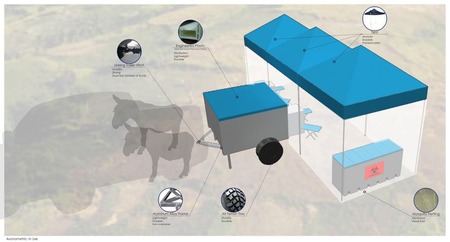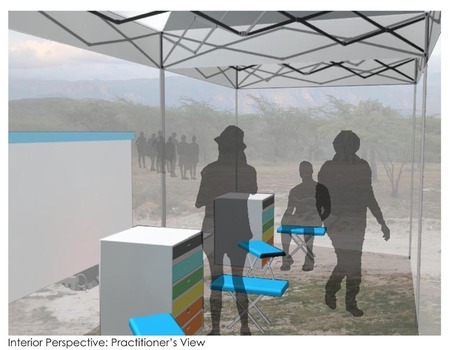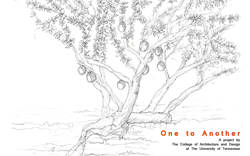U-haul-spital Mobile Clinic
 Saturday, February 16, 2013 at 9:54PM
Saturday, February 16, 2013 at 9:54PM  U-haul-spital in use with material call-outs. My design partner (Tiffiny Hall) and I created the U-haul-spital, an Emergency Medical Response Unit (EMRU) based off a small, off-road trailer that housed enough supplies to serve a community in need for an average of 5 days. As a team, we concentrated on the technical aspects and functionality of the unit, to insure the unit would accomplish its task; this included material and construction research and supplies organization
U-haul-spital in use with material call-outs. My design partner (Tiffiny Hall) and I created the U-haul-spital, an Emergency Medical Response Unit (EMRU) based off a small, off-road trailer that housed enough supplies to serve a community in need for an average of 5 days. As a team, we concentrated on the technical aspects and functionality of the unit, to insure the unit would accomplish its task; this included material and construction research and supplies organization
Tiffiny and I learned that research is the key to creating a successful project. Through our research, we found new materials, construction methods, and possibilities that helped us in designing the EMRU. Durability and mobility were major concerns as this unit is to be reused and will need to travel over any terrain; therefore, an engineered plastic trailer is to be attached to the aluminum alloy frame. The storage carts and tents are a modular system allowing for a maximum of adjustability. The reviewers—made from a group of design and medical professionals—believed that this aspect of the design was agreeable to the needs of Haitian and foreign medical practitioners alike.
 Distribution of EMRUs throughout HaitiDuring the critique the main issue was the logistics of dispersing, securing, and transporting the trailers. As a team, we spent a lot of time researching Haiti’s need for medical care in relation to the population density. As a pre-disaster unit, it is also meant to be used as a mobile clinic; additionally, the EMRU were to be housed at airports for ease of restocking supplies and initial transport. However, this prompts the question: Who funds, owns, and operates the units?
Distribution of EMRUs throughout HaitiDuring the critique the main issue was the logistics of dispersing, securing, and transporting the trailers. As a team, we spent a lot of time researching Haiti’s need for medical care in relation to the population density. As a pre-disaster unit, it is also meant to be used as a mobile clinic; additionally, the EMRU were to be housed at airports for ease of restocking supplies and initial transport. However, this prompts the question: Who funds, owns, and operates the units?
As a next step to the design process, we would need to look even more at the cultural aspects of post earthquake Haiti to answer the issues that were discussed in the critique. The logistics of ownership would need to be fully worked out to insure the success of the units in Haiti.
 Interior Perspective: Practitioner's View Final Presentation Board
Interior Perspective: Practitioner's View Final Presentation Board
 Clinic,
Clinic,  Haiti,
Haiti,  Mobile Medical Unit
Mobile Medical Unit 



Reader Comments (3)
The research and thoughtful consideration of how the unit would be distributed throughout the country is great. I think the flexibility and multiple setups of the system is also a positive. I think the main concern is how the supplies would be stored while not in use as you mentioned in your critique. Overall, well done and nice diagrams and drawings.
The design is very successful in the amount of research you dedicated to the materiality and construction. I appreciate the flexibility of the medical unit and its success in storing the medical supplies. Overall, the design accommodates the needs of a medical emergency but may need further attention in securing the unit. Great job!
The amount of dedication to the project through research was amazing. The details of where and how the medical supplies were stored are exact down to the last bottle. The design is one of the more successful of the class.